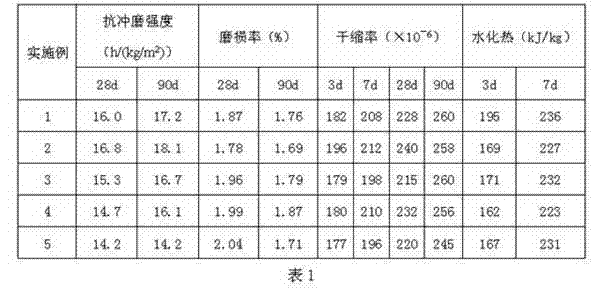Abrasion resistant low-heat portland cement
A Portland cement, anti-abrasion technology, applied in sustainable waste treatment, solid waste management, climate sustainability, etc. The high cost of engineering repairs and other problems can solve the problems of poor abrasion resistance, excellent abrasion resistance and low hydration heat.
- Summary
- Abstract
- Description
- Claims
- Application Information
AI Technical Summary
Problems solved by technology
Method used
Image
Examples
Embodiment 1
[0026] When formulating anti-scour low-heat Portland cement, the weight percentage of each component contained in the firstly prepared anti-scour mixture is:
[0027] Active Microsilica 84%
[0028] Ultrafine low calcium fly ash 15%
[0029] Superplasticizer 1%
[0030] After mixing the anti-scouring mixture evenly, mix it with finely ground low-heat Portland cement clinker and gypsum. The weight ratio is:
[0031] Low heat portland cement clinker 85%
[0032] Anti-abrasion compound 13%
[0033] Gypsum 2%
[0034] Among them, the average particle size of the low-heat Portland cement clinker is 0.1-0.3 μm;
[0035] Then, the three components are mixed uniformly through a cement mill, and the fineness is controlled to 12%, that is, the anti-scouring low-heat Portland cement is obtained.
Embodiment 2
[0037] When formulating anti-scour low-heat Portland cement, the weight percentage of each component contained in the firstly prepared anti-scour mixture is:
[0038] Active Microsilica 90%
[0039] Ultrafine low calcium fly ash 8.8%
[0040] Superplasticizer 1.2%
[0041] After mixing the anti-scouring mixture evenly, mix it with finely ground low-heat Portland cement clinker and gypsum. The weight ratio is:
[0042] Low heat portland cement clinker 85%
[0043] Anti-abrasion compound 13%
[0044] Gypsum 2%
[0045] Among them, the average particle size of the low-heat Portland cement clinker is 0.1-0.3 μm;
[0046] Then the components are mixed uniformly through a cement mill, and the fineness is controlled to be 12%, so as to obtain the anti-erosion low-heat portland cement.
Embodiment 3
[0048] When formulating anti-scour low-heat Portland cement, the weight percentage of each component contained in the firstly prepared anti-scour mixture is:
[0049] Active Microsilica 90%
[0050] Ultrafine low calcium fly ash 8.8%
[0051] Superplasticizer 1.2%
[0052] After mixing the anti-scouring mixture evenly, mix it with finely ground low-heat Portland cement clinker and gypsum. The weight ratio is:
[0053] Low heat portland cement clinker 90%
[0054] Anti-abrasion compound 8%
[0055] Gypsum 2%
[0056] Among them, the average particle size of the low-heat Portland cement clinker is 0.1-0.3 μm;
[0057] Then the components are mixed uniformly through a cement mill, and the fineness is controlled to be 12%, so as to obtain the anti-erosion low-heat portland cement.
PUM
| Property | Measurement | Unit |
|---|---|---|
| particle size | aaaaa | aaaaa |
| specific surface area | aaaaa | aaaaa |
Abstract
Description
Claims
Application Information
 Login to View More
Login to View More - R&D
- Intellectual Property
- Life Sciences
- Materials
- Tech Scout
- Unparalleled Data Quality
- Higher Quality Content
- 60% Fewer Hallucinations
Browse by: Latest US Patents, China's latest patents, Technical Efficacy Thesaurus, Application Domain, Technology Topic, Popular Technical Reports.
© 2025 PatSnap. All rights reserved.Legal|Privacy policy|Modern Slavery Act Transparency Statement|Sitemap|About US| Contact US: help@patsnap.com

